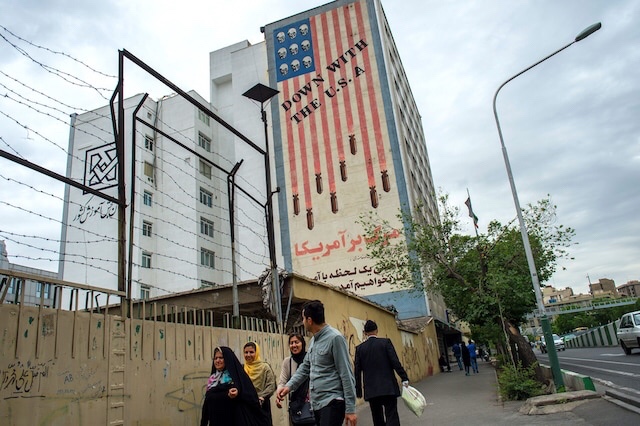David Wainer and Glen Carey | Bloomberg
August 21, 2020 at 12:02 a.m. MDT
1. What caused the conflict to escalate?
In May 2018, Trump withdrew the U.S. from a 2015 international agreement under which Iran agreed to limits on its nuclear work in exchange for relief from economic sanctions imposed by countries worried it was trying to develop a nuclear bomb. Trump argued he could get a better deal from Iran and began reimposing old sanctions and adding new ones. In May 2019, the U.S. stepped up the pressure by letting waivers expire that had permitted eight governments to buy Iranian oil. As with other sanctions campaigns, U.S. leverage rests with the central role American banks — and the U.S. dollar — play in the global economy. Any country, company or bank that violates the terms of the U.S. sanctions could see its U.S.-based assets blocked or lose the ability to move money to or through accounts held in the U.S. The Trump administration’s aim is to drive Iran’s oil exports, which account for almost half the country’s sales abroad, to zero.
2. Why does Trump oppose the nuclear deal?
He objects that its constraints are due to expire over time and says he wants to ensure Iran is prevented from having a nuclear weapon “forever.” He also complains that the accord does not address what he sees as Iran’s malign behavior in the Middle East, its support for terrorism or its ballistic missile program.
3. What’s been the impact on Iran?
Iran is producing oil at the slowest clip since 1986, making the sanctions one of the biggest challenges confronting its economy since the 1979 revolution overthrowing the monarchy and installing clerical rule. The sanctions have fueled inflation and undermined domestic support for President Hassan Rouhani’s government, which negotiated the nuclear deal. A surge in gasoline prices sparked protests in late 2019 that authorities put down with force that may have resulted in more than 1,000 deaths, according to U.S. officials. Iranians feel duped. The nuclear deal was supposed to yield economic advantages for Iran, but the renewed U.S. sanctions have shattered that expectation.
4. What has Iran done in response?
It’s confirmed that it surpassed agreed caps on its stockpiles of enriched uranium and exceeded the allowable level of purity. U.S. and Saudi officials have asserted that Iran was behind attacks in September 2019 on two Saudi crude oil production plants that created the single biggest disruption in supply on record. Iran denies it. (The attacks were claimed by Yemen’s Iran-backed Houthi rebels, who are battling the government of President Abdurabuh Mansur Hadi, which is backed by the Saudis.) The U.S. also blames Iran for a spate of vessel attacks in the Persian Gulf, which Iran denies as well.
5. Why did the U.S. kill an Iranian commander in Iraq?
The Pentagon said the general, Qassem Soleimani, was “actively developing plans” to attack Americans stationed in the region. Soleimani was the leader of the elite Quds force, a part of the Revolutionary Guard Corps, Iran’s premier military branch. Days earlier, dozens of Iraqi militiamen and their supporters had stormed the U.S. embassy complex in Baghdad to protest deadly U.S. airstrikes against Kataieb Hezbollah, one of a number of Iraqi militias armed by Iran that nominally fall under the command of the Iraqi armed forces. The U.S. strike on Kataieb Hezbollah came after a rocket assault on an Iraqi installation hosting U.S. personnel that killed an American contractor and wounded several U.S. service personnel. Trump had said in a tweet that Iran “will be held fully responsible” for the embassy assault as well as the killing of the U.S. contractor.
6. What’s threatening a crisis at the UN?
The U.S. on Aug. 20 called on the UN’s Security Council to restore all nuclear-related sanctions on Iran. Other world powers have said they won’t go along. Under the “snapback” process outlined in the 2015 deal, the Security Council has 30 days to approve a resolution to continue Iran’s sanctions relief, a move the U.S. could veto. If such a resolution isn’t adopted, the UN sanctions that were eased in return for constraints on Iran’s nuclear program would theoretically be restored, effectively killing the 2015 accord. But every other party to the deal, including China and America’s European allies, argues that snapback was a right given to the deal’s participants, and since the U.S. withdrew, its actions would be invalid. The U.S. disagrees, saying that UN Resolution 2231 lists it as a participant for purposes of snapping back sanctions.
7. What’s the history between the U.S. and Iran?
Discord between the two countries is rooted in U.S. backing for the 1953 coup ousting Iran’s nationalist prime minister and re-installing the monarch, Shah Mohammad Reza Pahlavi, who was sympathetic to the West. When Islamic revolutionaries took over Iran in 1979, forcing the shah to flee to the U.S., militants seized the U.S. embassy in Tehran and held 52 Americans hostage for more than a year, demanding the shah’s return. The U.S. severed relations and began to impose sanctions, which grew over the years. The U.S. has listed Iran as a state sponsor of terrorism since 1984. In 2019, it named the Revolutionary Guard a terrorist organization, the first time it applied that designation to a state institution.
For more articles like this, please visit us at bloomberg.com
No comments:
Post a Comment